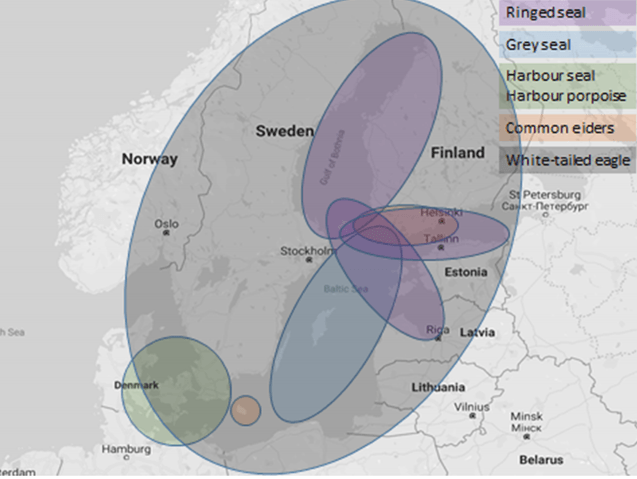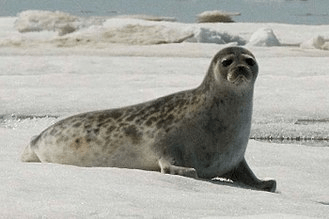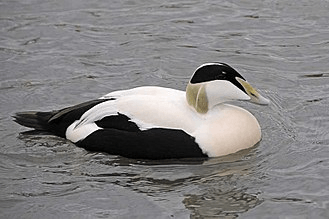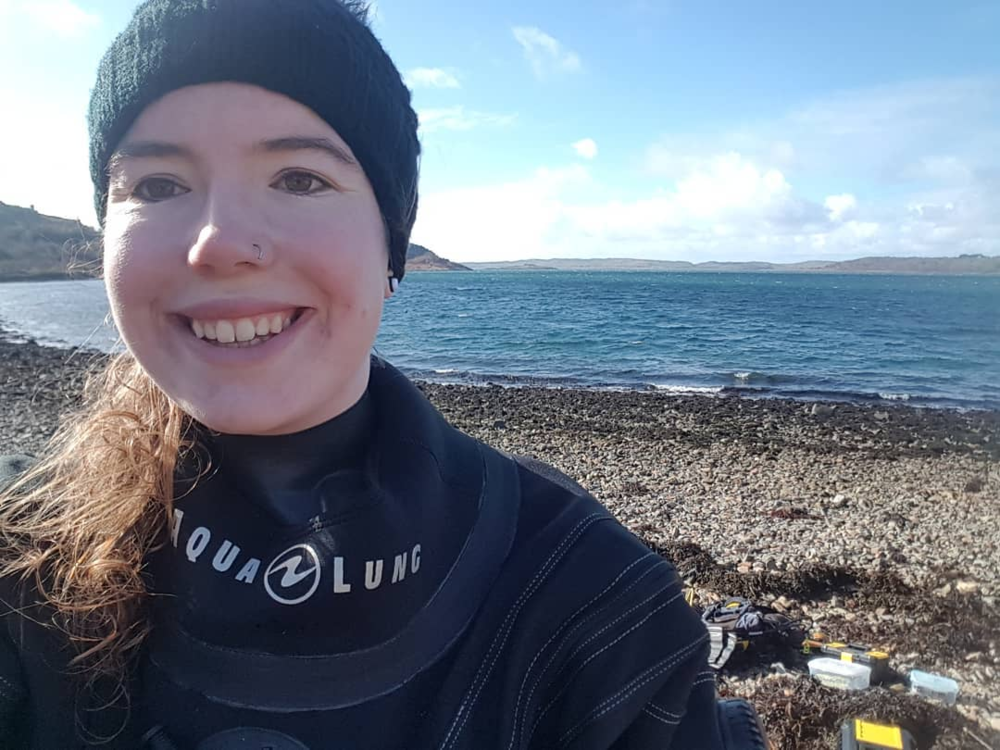HEALTH EFFECTS FROM ENVIRONMENTAL CONTAMINANTS IN BALTIC BIRDS AND MARINE MAMMALS.
Lottie Glover | 24th June 2020.
Many marine animals are exposed to industrial hazardous substances. Persistent organic pollutants (POPs) are anthropogenic organic compounds that are also known as “forever chemicals”.They are resistant to degradation, thus they accumulate in the environment and can have adverse health effects on wildlife and humans.
The Baltic Sea has low salinity levels and is exposed to anthropogenic activities such as fishing, military activity, and transport. Key species and POPs have been studied for over 70 years in the BalticSea, making it the ideal ecosystem to study. Individual-level effects of POPs have been well studied, but population-level effects have not. We need to understand how pollution effects species at a population-level so we can effectively manage and conserve wild populations.
A review by Sonne
et al., (2020) summarised the adverse health effects of POPs on the populations of the following high trophic indicator species: common eider, white-tailed eagle, harbour porpoise, harbour seal, ringed seal, and grey seal. The review used organ-tissueend points (pathologies) and biomarkers to identify population level effects on these key species. However, there was limited data available on the eider to establish population-level effects of POPs exposure.
Please see terminology section below for some of the words used regarding health problems.
The Baltic Seal Disease Complex (BSDC) is a disease syndrome seen the Baltic Sea, North Sea and German Bright in ringed and grey seals caused by POPs exposure. It was seen from 1977-1983, however it may still occur today at a lesser extent. Polychlorinated biphenyls (PCBs) and Dichlorodiphenyl trichloroethane(DDT) have been identified as the POPs that caused the syndrome. PCBs are used in paints, plastics and capacitors. DDT was used in agricultural insecticides.BSDC causes various health problems including reduced bone density, hyperplasia of adrenal glands, and high levels of cortisol (likely due to stress). During the time period of 1977-1983, prevalence of occlusions and stenosis of the uterus were as high as 30% in grey seals and 70% in ringed seals. One study by Bredhult
et al., (2008), looked at the relationship between concentrations ofPCBs and DDT, and leiomyoma from 1973-2007. They found neoplastic changes in female seals aged 20-40 years old, with a prevalence of 65%. Most BSDC symptoms, especially in the reproductive tract, had reduced by the 1990s in theBaltic Sea, following the 1970s DDT ban and a reduction in PCBs.
POPs had impaired reproduction in grey seals causing a population decline in the 1960s and 1970s. Pregnancy has now increased, with the birth rate of grey seals in Finnish waters being at around88%. Adult seals now only show minor renal BSDC symptoms.
The white-tailed eagle populations in theBaltic Sea are were also heavily affected by POPs, in particular DDT. DDT caused eggshell thinning until the 1990s, leading to the failure of eggs hatching. Scandinavian populations have now recovered since the use of DDT was more effectively regulated.
Skeletal problems have also been discovered in the three seal species as a result of POP exposure. Skeletal health effects seen in ringed and grey seals include changes in bone mineral density, fluctuating asymmetry, and severe periodontitis. In the Baltic Sea, a high prevalence of alveolar bone loss and exostosis was found in harbour seals.Following World War II, a reduced developmental stability was high in harbour seals, coinciding with high level of contaminants. Developmental stability increased after 1988, most likely due to a reduction in contamination. A significant increase of pathological lesions from 1981 to 2014 were seen in the skulls and mandibles of harbour seals in the waters surrounding Denmark, and these skulls with lesions had higher asymmetry. One theory for this increase is due to a reduction in food quality and quantity, and an increase in PFAS (per- and polyfluoroalkyl substances).
Harbour porpoises are also affected by POPs and metals such as mercury, causing an increase in bacterial and parasitic infections. POPs can also affect the functioning of the thyroid in harbour porpoises by replacing the thyroid follicles with connective tissue. The thyroid plays a major role in metabolism and development, so negative effects on this hormone gland could have serious consequences on the harbour porpoise.
Vitamins can be reliable biomarkers for the exposure of PCBs and DDT. The bone lesions and reproductive failures seen inBaltic seals was likely associated with increased thyroid hormone concentrations and reduced concentrations of vitamin D. An increase in cortisol has also been linked to changes in bone density. Thiamine (Vitamin B1)deficiency may have contributed to the mortality of marine birds in the BalticSea through paralysis of the wings, followed by complete paralysis. The decline of the common eider population in the Baltic Sea is associated with the high mortality of ducklings, causing abnormal behaviour and increase in predation, with a thiamine deficiency being a likely contributor. Along with vitamin deficiencies due to the exposure of POPs, common eiders have also experienced a reduction in their food. These factors are likely to be affecting the population size and dynamics. These population-level effects on the common eider need to be investigated further.
This review found that although the use of many environmental contaminants has been banned, reduced or better monitored, the six key species in the Baltic Sea are still affected today. There are multiple stressors present in the Baltic Sea alongside environment contaminant exposure. New technology is needed to integrate the various health impacts of these stressors to improve the understanding of population-level effects. New contaminants continue to leak into the environment, so we need to continue monitoring these key species and continue to develop models to include other factors such as climate change.
Terminology:
- Hyperplasia- enlargement of an organ or tissue due to an increase in cell reproduction rate
- Occlusion- blockage or closing of a blood vessel of hollow organ.
- Stenosis- abnormal narrowing.
- Neoplastic change- abnormal growth of cells(a tumour).
- Periodontis- a severe gum infection that can cause a loss of teeth.
- Alveolar bone- the thickened ridge of bone that contains the tooth sockets on the jawbone.
- Exostosis- the formation of new bone on top of a bone.
- Pathological lesions- lesions caused by disease or injury.
- PFAS- another persistent organic pollutant widely used by consumers and industry.
References:
Bredhult, C., Backlin, B., Bignert, A. and
Olovsson, M. 2008. Study of the relation between the incidence of uterine
leiomyomas and the concentrations of PCB and DDT in Baltic gray seals. Reproductive
Toxicology.
25
(2), pp. 247-255.
Sonne, C. Siebert, U., Gonnsen, K., Desforges,
J., Eulaers, I., Persson, S., Roos, A., Backlin, B., Kauhala, K., Olsne, M. T.,
Harding, K. C., Treu, G., Galatius, A., Andersen-Ranberg, E., Gross, S.,
Lakemeyer, J., Lehnert, K., Lam, S., Peng, W. and Dietz, R. 2020 Health effects
from contaminant exposure in Baltic Sea birds and marine mammals: A review.
Environmental
International
.
139
, 105725

















